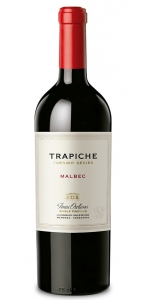Wine from Trapiche
Like no other, we understand the strength of the viticulture in Argentina, and therefore specialize in obtaining the best from every acre to create unique and premium wines. Our vineyards encompass more than 2,470 acres of Argentine terroir, and we obtain grapes from more than 200 independent producers in the best wine-growing areas of Argentina.
Winemaker:
A native of Argentina, Daniel strives to reflect the diversity of Argentina’s regions in his wines. His knowledge of which areas are best suited to each varietal ensures that Trapiche wines are exemplary.
Trapiche is dedicated to creating the best Malbec wines in the world, as demonstrated by the Terroir Series. Each year, in recognition of the Malbec growers’ passion and dedication, Daniel Pi and his team select three of its best Malbec growers and bottle their wines exclusively with the name of the grower and vineyard on the label of these single vineyard selections. The results are wines with their own special character, reflecting the land and the grower’s uniqueness.
Trapiche Terroir Series Finca Orellana is made from 100 percent Malbec.
The history of Trapiche begins in 1883, in a small vineyard called El Trapiche, in the district of Godoy Cruz, Mendoza, where the grapes for the first fine wines were grown. With more than 130 years of experience, Trapiche has earned its place as a pioneering brand in the introduction of French vines, the production of varietal wines, the import of French oak barrels and the use of stainless steel tanks. True to its origins, today Trapiche is in a continuous quest for the latest best practices .Led by Daniel Pi, Director of Winemaking, Trapiche's winemaking team permanently strives to improve winemaking practices by exchanging experience and knowledge with winemakers from other wine producing countries such as France, the US, Australia and New Zealand.
With a deep garnet red color, this Malbec expresses aromas of red fruits such as cherries and currants, and intense balsamic notes with hints of fresh herbs. In the mouth, it is sweet and broad with a great concentration of fruit and soft, ripe tannins. It has a long, persistent and elegant finish.
Review:
El Peral may not be on the radar of many Argentine Malbec lovers. But if you take a look at Descorchados, you will realize that here we are fans of this area, a place of gentle hills, streams and trees. This vineyard was planted in 1946, and today it delivers deliciously liquefied fruit, with hints of cherries and cassis, but above all violets and blackberries in a long and deep body. Give it at least ten years in the bottle.
-Patricio Tapia - Descorchados 95 Points
-Tim Atkin 95 Points
- back
Selected Options
Wineries
Categories
Pricing
Countries
Regions
Grape Types
Wineries
Organic/Free Shipping
Joseph Phelps Vineyards Cabernet Sauvignon is made from 92% Cabernet Sauvignon, 4% Petit Verdot, 2% Cabernet Franc, 1% Merlot, 1% Malbec.
A classic Napa Valley Cabernet Sauvignon with inviting violet, dark fruit, tobacco, subtle baking spice and earthy dried herb aromatics. The palate is filled with expressive black cherry, blackberry and dark plum, hints of spice box and sweet vanilla bean. A focused, concentrated wine with youthful energy and freshness nimbly balanced by supple tannin structure and finesse.
Review:
Blackcurrants, spiced cedar and dark spices with bark undertones. Full-bodied with very fine, velvety tannins. Textured and compact with a firm, lingering finish. Tight at the end. Needs time to open.
-James Suckling 94 Points
100% apple wine. A blend of Golden Delicious and Fuji apples hand-picked in the Shenandoah Valley; aromas and flavors of freshly harvested apples, blossoms and spices. (semisweet)





